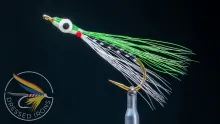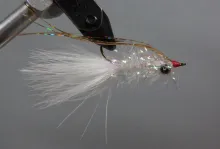There are a few things you can count on when you read a book by Lefty Kreh - good storytelling, just-the-facts brevity, a conversation tone to the writing, and lots of practical no-nonsense advice.
Updated or edited 9 months ago
There are a few things you can count on when you read a book by Lefty Kreh - good storytelling, just-the-facts brevity, a conversation tone to the writing, and lots of practical no-nonsense advice. In "Fly Fishing for Bass", Lefty continues this trend by filling the 143 pages with lots of his book with all of the above, and more.
The bulk of the book is devoted to the two most popular species of bass - the smallmouth and the largemouth. In addition, Lefty introduces the anglers to some exotic bass - the explosive peacock bass, which is gaining popularity as a "destination" fish, and the lesser known Niugini bass of New Guinea (Do you think it's a coincidence that the Nuigini bass is found in New Guinea? Me either.)
The book opens with a brief biological overview of the fish, with information about their preferred habitat, their spawning cycles, and the geological range in which the fish can be found. While these sections are not encyclopedic in the amount of information given, they do their job as far as setting the stage for the rest of the book.
The next major section of the book deals with tackle. As you would guess, Lefty has strong opinions about rod, reels, and lines. I found it interesting that he would recommend 8wt rods for smallmouth and 9wt rods for largemouth as the generic "all around" rods, but I was not surprised at all to hear him praise a medium fast action rod in stark contrast to many authors would would recommend a slow action rod for bass bugging. I sometimes think Lefty forgets that most of us can't handle an 8wt rod for a day of bass bugging without winding up with our arms in a sling. Still - you ignore Lefty's advice at your own peril. The guy has been around the block a time or two.
Included in the section on tackle is a discussion of flies. If you've ever read Lefty Kreh before, you know he's not into "eyeballs and assholes" flies. He definitely chooses flies less for their looks and attraction to the angler than their effectiveness on the water. One such example would be Lefty's Bug, which is about as plain a topwater bass bug that you can possibly imagine. Most fly tyers would find it all but impossible to finish that bug without adding a few strands of rubber sticking out of the sides, or a hackle skirt, or even big plastic goggles eyes. Lefty would be quick to tell you that none of those things will make the fly fish better, but sometimes you gotta do what you gotta do.
The book finishes with a discussion of angling tactics. While Lefty is certainly known worldwide for his casting skill, he didn't learn how to cast to do tricks at outdoor shows. He learned to cast so that he could fish. He covers techniques for lakes, rivers, and streams, and this is a section of the book where anglers of all levels would be well advised to slow down and read carefully, as here is where packs in a tremendous amount of information in a small space.
Don't be fooled by the diminutive looks of this book. Just like Lefty's Bug, there's no fluff. It's all "to the point".
- Log in to post comments







